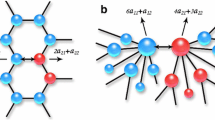Abstract
Evolutionary game dynamics have been traditionally studied in well-mixed populations where each individual is equally likely to interact with every other individual. Recent studies have shown that the outcome of the evolutionary process might be significantly affected if the population has a non-homogeneous structure. In this paper we study analytically an evolutionary game between two strategies interacting on an extreme heterogeneous graph, the star graph. We find explicit expressions for the fixation probability of mutants, and the time to absorption (elimination or fixation of mutants) and fixation (absorption conditional on fixation occurring). We investigate the evolutionary process considering four important update rules. For each of the update rules, we find appropriate conditions under which one strategy is favoured over the other. The process is considered in four different scenarios: the fixed fitness case, the Hawk–Dove game, the Prisoner’s dilemma and a coordination game. It is shown that in contrast with homogeneous populations, the choice of the update rule might be crucial for the evolution of a non-homogeneous population.
Similar content being viewed by others
References
Antal T, Scheuring I (2006) Fixation of strategies for an evolutionary game in finite populations. Bull Math Biol 68:1923–1944. doi:10.1007/s11538-006-9061-4
Antal T, Redner S, Sood V (2006) Evolutionary dynamics on degree-heterogeneous graphs. Phys Rev Lett 96. doi:10.1103/PhysRevLett.96.188104
Broom M, Rychtář J (2008) An analysis of the fixation probability of a mutant on special classes of non-directed graphs. Proc R Soc A 464:2609–2627. doi:10.1098/rspa.2008.0058
Broom M, Rychtář J, Stadler B (2009) Evolutionary dynamics on small order graphs. J Interdiscip Math 12:129–140
Broom M, Hadjichrysanthou C, Rychtář J (2010) Evolutionary games on graphs and the speed of the evolutionary process. Proc R Soc A 466:1327–1346. doi:10.1098/rspa.2009.0487
Fu F, Wang L, Nowak MA, Hauert C (2009) Evolutionary dynamics on graphs: efficient method for weak selection. Phys Rev E 79. doi:10.1103/PhysRevE.79.046707
Fudenberg D, Nowak MA, Taylor C, Imhof LA (2006) Evolutionary game dynamics in finite populations with strong selection and weak mutation. Theor Popul Biol 70:352–363. doi:10.1016/j.tpb.2006.07.006
Lieberman E, Hauert C, Nowak MA (2005) Evolutionary dynamics on graphs. Nature 433:312–316. doi:10.1038/nature03204
Masuda N (2007) Participation costs dismiss the advantage of heterogeneous networks in evolution of cooperation. Proc R Soc B 274:1815–1821. doi:10.1098/rspb.2007.0294
Masuda N (2009) Directionality of contact networks suppresses selection pressure in evolutionary dynamics. J Theor Biol 258:323–334. doi:10.1016/j.jtbi.2009.01.025
Nowak MA (2006) Evolutionary dynamics: exploring the equations of life. Harvard University Press, Cambridge
Ohtsuki H, Hauert C, Lieberman E, Nowak MA (2006) A simple rule for the evolution of cooperation on graphs and social networks. Nature 441:502–505. doi:10.1038/nature04605
Santos FC, Pacheco JM (2006) A new route to the evolution of cooperation. J Evol Biol 19:726–733. doi:10.1111/j.1420-9101.2005.01063.x
Sood V, Antal T, Redner S (2008) Voter models on heterogeneous networks. Phys Rev E 77. doi:10.1103/PhysRevE.77.041121
Szolnoki A, Perc M, Danku Z (2008) Towards effective payoffs in the prisoner’s dilemma game on scale-free networks. Physica A 387:2075–2082. doi:10.1016/j.physa.2007.11.021
Tarnita CE, Ohtsuki H, Antal T, Fu F, Nowak MA (2009) Strategy selection in structured populations. J Theor Biol 259:570–581. doi:10.1016/j.jtbi.2009.03.035
Tomassini M, Pestelacci E, Luthi L (2007) Social dilemmas and cooperation in complex networks. Int J Mod Phys 18:1173–1185. doi:10.1142/S0129183107011212
Voelkl B (2010) The ‘Hawk–Dove’ game and the speed of the evolutionary process in small heterogeneous populations. Games 1:103–116. doi:10.3390/g1020103
Author information
Authors and Affiliations
Corresponding author
Electronic Supplementary Material
Below is the link to the electronic supplementary material.
Rights and permissions
About this article
Cite this article
Hadjichrysanthou, C., Broom, M. & Rychtář, J. Evolutionary Games on Star Graphs Under Various Updating Rules. Dyn Games Appl 1, 386–407 (2011). https://doi.org/10.1007/s13235-011-0022-7
Published:
Issue Date:
DOI: https://doi.org/10.1007/s13235-011-0022-7




